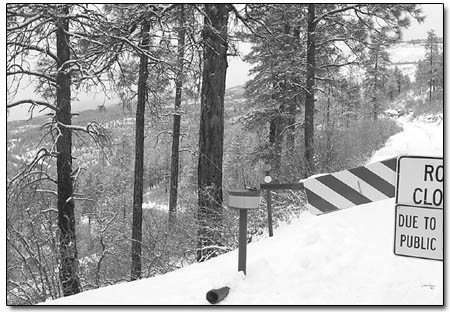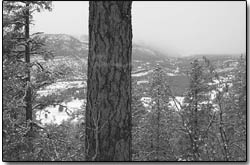|
Colorado Wild files lawsuit days before first
sale goes out to bid
by Missy Votel
 |
| Partially burned trees dot
the landscape along Missionary Ridge Road, which is still
closed to public access. A plan to log the burn area was approved
by the Forest Service last summer despite objections from
environmental groups. In a last-ditch effort to halt the current
logging plan, Colorado Wild filed a lawsuit last week, seeking
an injunction on the first timber sale, which was slated to
start this month./Photo by Todd Newcomer. |
Although the Missionary Ridge Fire has been out for more than
a year, debate over logging in the burned area still rages, now
reaching as far as federal court. On Dec. 24, a mere few days
before the San Juan National Forest was to put the area’s
first timber sale out to bid, Colorado Wild filed a lawsuit in
U.S. District Court in Denver, claiming that the logging violates
the National Environmental Policy Act and the National Forest
Act.
A lawyer for Colorado Wild, a Durango-based environmental group,
said he hopes to gain a preliminary injunction sometime in the
next two weeks that would halt the sale until the case can be
heard.
“We’d likely request a preliminary injunction because
it’s such a short time line,” said Colorado Wild lawyer
Geoff Hickox. “Typically, a judge will rule right or shortly
afterward.”
Although Colorado Wild is listed as the sole plaintiff, Jeff
Berman, executive director of Colorado Wild, said the lawsuit
is on behalf of conservation groups throughout the state.
“We work in partnership with all the other environmental
groups in Colorado,” he said, adding that certain groups
focus on certain areas so as not to duplicate efforts. “Colorado
Wild works on timber sales, and other conservation groups look
to us to address this kind of stuff.”
He said although his group objects to the logging on many levels,
the lawsuit deals only with areas of the plan that may break the
law – namely road construction, steep slope logging and
lack of mitigation measures, which all could lead to a sullied
watershed and NEPA violations.
“There is a difference between concerns and violations
of the law,” he said. “Only violations of the law
are included in the lawsuit.”
The salvage logging sale was approved in mid-July and called
for the speedy harvest of 13.4 million board feet of dead and
dying timber on approximately 3,388 acres, including 1,300 acres
of land deemed “high erosion hazard areas” by Colorado
Wild. The decision also called for the reconstruction of 76 miles
of existing roads and construction of 3 new miles of temporary
roads. Since early spring, the sale has been on a fast track in
order to harvest the burned timber before it rots and loses value.
However, the lawsuit is likely to change all that, according
to Dave Dallison, timber program leader with the San Juan Public
Lands Center.
“The first sale was due to be advertised any day,”
said Dallison on Monday. “(The lawsuit) definitely will
cause a delay, which is a concern because dead timber deteriorates.”
According to Dallison, ponderosa pine, for example, loses its
value within 18 months. He added that depending on whether a judge
grants the injunction, the delay could push timber harvest into
the spring and summer, when the ground is more vulnerable.
“We were hoping to do logging in the winter, operating
up on the snow, but the delay will push logging toward summer,
which is unfortunate,” he said.
Aside from losing time, Dallison said for every moment the timber
is allowed to sit, the public is losing money as well.
“The more it deteriorates, the more the taxpayer loses,”
he said.
However, Berman said if the salvage logging goes through as planned,
taxpayers stand to lose even more in the form of water quality,
erosion and wasted reseeding efforts.
 |
| A partially charred tree tagged
with a blue marker stands on Missionary Ridge Road. Under
a plan approved by the Forest Service last summer, more than
3,000 acres of burned forest would be salvage logged./Photo
by Todd Newcomer. |
“We as taxpayers paid to reconstruct Missionary Ridge Road
– a tremendous amount – even though its main use for
the next several years is only going to be for logging,”
he said. “The same goes for aerial seeding. Taxpayers have
spent money to control erosion and get vegetation growing. Logging
will undermine those efforts.”
Of chief concern to Berman is steep slope logging, which would
pluck trees from the more vertical areas using helicopters.
“We don’t have a lot of steep slope logging in Southwest
Colorado, and wisely so,” he said.
According to Berman such logging practices in other areas have
led to massive erosion and mudslides, which in turn taints water
supplies with run-off. “Generally, it’s not advisable,”
he said.
Additionally, Berman noted that steep slope logging can be a
double–edged sword in that it costs more and forces loggers
to cut corners – namely mitigation. He added that the low
value of the burnt timber also may cause loggers to cut costs.
“Because of the low value of the burnt timber, it’s
not likely mitigation will be adhered to,” he said.
And while Dallison said that loggers are required to reseed areas
they impact, Berman maintains that mitigation measures in the
Forest Service’s Final Environmental Impact Statement were
cut out or worded in such a way that they appear voluntary.
“They contain disclaimers like ‘should’ and
‘if possible’ 85 amounting to what are essentially
optional measures,” he said.4
However, Berman said the main worry comes not from the logging
itself, but creating access to the logging areas.
“Roads are known to be the greatest source of erosion,”
he said. “The Forest Service did not account for this in
their decision.”
All in all, Berman said in going ahead with the logging, the
Forest Service ignored recommendations not only from his group,
but others, including the Environmental Protection Agency.
However, Dallison said the Forest Service did all it could to
address concerns over the logging plan given the compressed timeframe.
“We started with a proposal that was pretty reasonable,
covering only 5 percent to 6 percent of the burn area,”
he said. The Forest Service also had a “lengthy” conference
call with the EPA to discuss concerns over the watershed and hired
an independent consultant – a “national expert,”
according to Dallison – to address the issue.
“Most concerns were resolved at that time,” he said.
“We came to agreement with just about everyone except Colorado
Wild. We felt pretty good about the work that was done.”
Dallison also said that a Forest Service study found watershed
concerns unfounded, and that the logging may even help mitigate
erosion.
“Our analysis shows no effects or positive effects to the
watershed,” he said of the logging effort, which he expects
to last from one to three years.
Nevertheless, Berman sees the undertaking, on already sensitive
soils, as risky as best.
“This is not a time to exacerbate water problems, not a
place to be taking risks,” he said.
He adds that the lawsuit is not an attempt to shut down logging
all together, but to ensure that the Forest Service goes about
it the right way.
“You can have some wood fiber logging for homes and to
create jobs, it just has to be done sustainably,” he said.
“But this is the epitome of unsustainability: a lot of timber
that has to be logged in a short time in the wrong place.”
|

